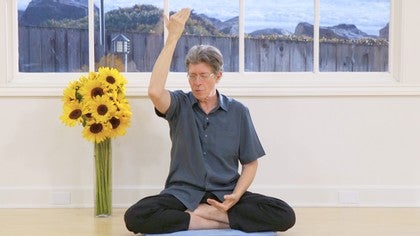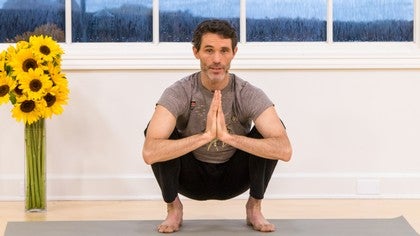Description
About This Video
Transcript
Read Full Transcript
Greetings. Robert Svoboda here, with a simple meditation for you to employ to assist you to become more familiar with Pratyahara. With creation of a sense of interiority, inside your own personal self. For this purpose I'd like for you to sit in a comfortable position. If you can sit cross-legged that's very nice, otherwise there's no need, sit on a chair, but sit comfortably so that you're not going to have to move for the next 10 or 15 minutes.
Sit comfortably, and with a back that is not ramrod straight, but is comfortably straight. Create a sense of poise in yourself, and when you're ready, close your eyes. When your eyes are closed, you will first remind yourself that you are overjoyed that you actually have eyelids, because otherwise if you had no eyelids, you'd be looking at the world 24 hours a day, which would become exhausting very, very soon. Very, very quickly. So, be thankful for your eyelids.
Particularly, in the context of this exercise, because when you close the eyelid, and you disconnect the external eye from the external world, you can open the inner eye. The faculty of vision is not limited to your eye. The faculty of vision happens to be channeled very efficiently through your eye, but the faculty of vision is available to any part of you at any time. We find that, generally speaking, the vision sense is the one sense in humans that is most important. We reflect this in the language that we use.
We are often called upon to envision, to visualize or to imagine, that's image-ine. We're as far as I'm concerned, never called upon to en-smell, en-taste, touch-ify, or hear-ize. So, vision is a very important sense, because it gives us the representation of what we think of as the external world. We look around us, we see things, and we believe this to be the outside world, when in fact, all that this is, is a representation of the outside world that has been generated inside our organism. In the head by the visual cortex, but in the Pranic body by the Manipura, by the so-called Hara, down here.
So what we're going to do is take advantage of that internal sense of sight, one that so far as we can tell, was not created by, but was enhanced by several orders of magnitude, by the harnessing of fire, an event which took place long before our species was actually engendered. And we're going to use that sense of vision to assist us to become more familiar with the insides of our body. So again please close your eye, and open your internal eye. It may take you a while to become familiar in the same way that it may take you a while once the lights go off and you have to look around in the dark, your eyes need some time to adjust, so it may take a little time for your eyes to adjust to the new world that you are seeing here. And it is not really desirable to become to caught up in trying to actively project or hallucinate what you're seeing on the inside.
All that you're trying to do is be open to allowing your sight to provide you information that it would not be able to provide you if as is usually the case while you're awake, that sense of sight is externally projecting itself in all directions. So, close your eyes, and start to look around in your organism. Start first inside your head, because that's where you think of is where your eyes are. Start first inside your head. Look in your skull.
Look around. Don't at the moment try to see anything other than whatever it is you might see or not see, whatever it is you might sense or not sense. The use of the external eye is, because the external eye is standardized in the human being, the use of the external eye is pretty much standardized in the average human being. But the internal eye is not standardized, because we don't have an internally-focused physiological organ to channelize that visual reality as we do to have it channelized externally. So how something may display itself on the inside, how it may represent itself to you, is something that will be very specific to you.
You may hear how other people do it. You may read and see other forms of representation, but whatever is eventually going to work for you, is something that you personally are going to have to work out. So while your eyes are closed, you're looking around in your head. After a while you get tired of looking around in your head. You move down into your throat.
You look around in your chest. The lungs are there, the heart is there. There is some ribs. There is some intercostal muscles. You look a little further, there's the giant muscle we call the diaphragm underneath which is the liver on the right side, and the spleen on the other side, and the J-shaped stomach in the middle.
And the duodenum, and the small intestine, which is all packed in there, and the large intestine, which is also all packed in there, but a little more obvious because it is going in sort of a U-shaped form. And then there's some retroperitoneal organs we call the kidneys. And then there's a bunch of stuff down in the pelvis. And then you exit down into the thighs, and move around in the lower legs and the calves. You get to the feet.
You come back or up. You go out into one arm and one hand. You come back, you go out into the other arm and the other hand, you come back. All you're trying to do right now is get some sense of what that eye is doing, and what that eye might be able to see. And we're going to add in one more factor, and that is the factor of the Prana.
One thing that we do want the eye to be able to see on the inside, is how the Prana is circulating inside your organism. Because then you can use your eye, not always, will not always work for you, but often it will, you can use that eye to identify where a particular blockage is in your system. So we're gonna start off, while you still have your eyes closed, by doing this. With your eyes closed, take one hand, either hand, often it's better to use your non-dominant hand, just because it's non-dominant. So it allows you to experience things in a slightly different way.
And move it, let it touch your skin, but just, just, just barely. Barely touching your skin, move the hand over your skin. Over your different parts of the skin, different parts of the body. Some places there's hair, some places there's none. Some places is dry and rough, some place it may be smooth.
Some places are bonier, some places are softer. And what you're doing for yourself, because you're keeping your eyes closed all this time, what you're doing for yourself is you are giving yourself a sense, while your eye is closed, you're giving yourself a sense of the boundaries of your physical body. So you're letting your inner eye become familiarized with the boundaries of your external physiological body. Once you've done this for a few moments, let your arms go back down to a comfortable position, wherever it happens to be, and then you are going to for a moment, let your inner eye explore the limits of your Sukshma Sharira, or your mental body, or your subtle body. The body that's made up of thoughts and emotions and memories, and is made sick by thoughts and emotions and memories, and is treated and healed by thoughts and emotions and memories.
And you will find very quickly that that mental body is limited by pretty much nothing at all. While you are in this state, you can take your mind and move it to the north star if you wanted to, or the center of the earth, or it can go anywhere, it can do pretty much anything. Whatever you can visualize it doing, is something that it can do. So, you see that there is a limitation to your physical body, a limitation that is not shared by your subtle body. And the subtle body can go anywhere inside the physical body.
And everywhere it goes inside the physical body, it is going there being transported by the Prana. So now you have a better idea about the subtle body, which can go anywhere, and the physical body, which is definitely limited by physical form. Which brings us to the Pranic or the etheric body. The body of this vital force we call Prana. This becomes a little bit more subtle, so now what you wanna do, is you want to bring your hands together, kind of facing one another, about six inches apart, you still have your eyes closed, and you want to now try to get a feeling of how far outside your skin, not your mind, but how far outside your skin your vitality happens to exude.
So, you know how far your skin is extended, but your vitality is, when you're looking with your internal eye, if you didn't know that this is where your skin is, where would it feel like your skin might be? How big might your body actually feel if you allowed it to feel how big it is from the perspective of that vital force we call the Prana? And this is a subtle thing, but Prana is a subtle thing. Sometimes it takes a little bit of experimentation to be able to sense and perceive and utilize these subtle things. If you were to feel to yourself, how far out does my energy actually go?
You're trying to sit here for a moment just to get the energy to move between your palms, and then perhaps you would even move your palm over your limbs, and try to get a feeling for exactly how far out, and this will change from day to day. Some days, particularly if you're feeling tired or frazzled or discombobulated, the Prana will not be able to extend itself very far out of your system. The days on which you're feeling well-integrated and enthusiastic, the Prana can extend itself out much further. So what you're trying to do now, with that inner eye of yours, is to see just how far the Prana is extending out of your organism. Just to see how Pranic your, the envelope that surrounds you is.
And again trying to see, are there areas, as that inner eye of yours moves around in your organism, are there areas where perhaps the inner eye cannot go? Or areas that look dark, or areas that look congested? Or look like some sort of, there's some sort of condensation or precipitation, or something that has congealed in a certain area, and is not permitting your awareness to penetrate it? If your awareness cannot penetrate it, your Prana cannot penetrate it, and that's an area, an energetic area to begin with, but could easily become a physiological area where some kind of devitalization has or will occur, and where there is devitalization, disease is very likely to occur. So while your eyes are still closed, now take your inner eye down to your perineum, to the point between your genital organ and your anus.
And we're not going to get into what the Daoists call the microcosmic orbit, right now. We're going to do something much simpler. And that is simply to take your inner eye and move it directly up whatever feels to you like the center of your body, and let it move up to the top of your head, and then let it move back down to your perineum. Back up to the top of your head. Back down to your perineum.
Up to the top of your head, down to your perineum. So you're trying to get the internal eye to become comfortable moving in the most central location in your organism, that pillar of Pranic reality around which the entire organism is fashioned. Around which the entire organism is arranged. That thing which holds the organism in place by virtue of the organism holding it in place. So you allow the inner eye to move up along this central column, and you allow it to move back down.
As your attention moves, your Prana will start to move as well. And you will find that as you move your Prana up and down, that your sense of being centered will increase, and it's very likely that your sense of how far the Prana extends out away from your skin, will also increase as you feel better integrated. Do this for another couple of breaths. Remember that all during this exercise you should have been breathing very calmly, very deeply and very regularly. And when you feel like you have achieved enough for one session, open your eyes about half way, and start the process of returning awareness to the external world, while maintaining awareness of the internal world.
And while informing your external organ of sight that you're only going to allow it to operate under the conditions that you dictate to it. You will not allow it to drag your awareness and your mind in all kinds of different directions that may not be valuable for it, simply because it has been allured by something that was attempting to allure it. And once you feel stable with that internal awareness being preserved, all the while the external awareness is being reawakened, open your eyes all the way, and try again to keep aligned with the Prana on the inside, even while you return yourself to that external reality. Thank you, namaste.
Prana: Robert Svoboda & Scott Blossom
Comments
 very useful! Thank you! ??
very useful! Thank you! ??
You need to be a subscriber to post a comment.
Please Log In or Create an Account to start your free trial.














